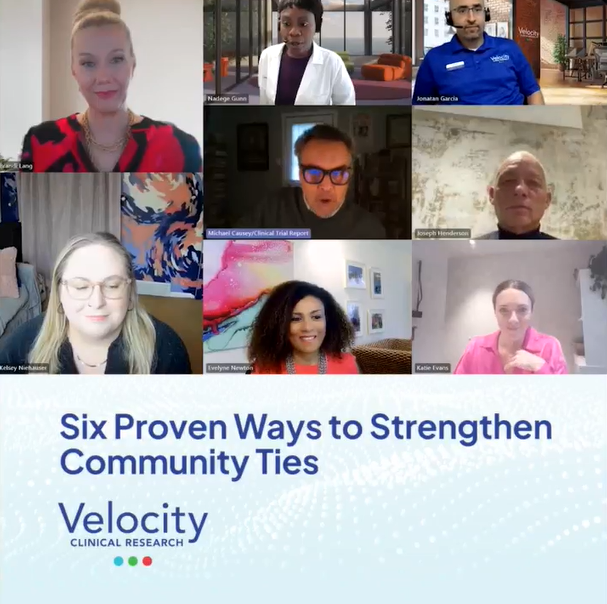Velocity recently asked some key employees to come together and discuss a wide array of issues impacting diversity, equity, and inclusion (DEI) in trials. Velocity’s ongoing goals are to share best practices, identify and address shortcomings, and bring as many perspectives and viewpoints to the table as possible to advance clinical trials and deliver vital new drugs and treatments to patients quicker.
In this article, Velocity experts discuss how to build trust and recognition to develop stronger connections with local communities and increase patient diversity in clinical trials.
Joining the discussion was Nadege Gunn, MD, CPI, Principal Investigator in Waco, TX; Joseph Henderson, Community Liaison in Durham, NC; Kelsey Niehauser, Communications Specialist and former clinical trial participant; Evelyne Newton, VP Business Development, Europe; Jonatán Garcia, Community Liaison in Waco, TX; Brandi Lang, Chief Legal Officer; and Carlos Barcenas, former clinical trial participant and Founder of I Choose Purple in Grand Island, NE.
Here are six proven tips shared by the Velocity panel to enrich community relations:
1. Be visible. There’s no substitute for connecting with people in person, and it is most effective to go to their locations to connect. Visit churches and other religious organizations to meet congregations, hold meetings with local non-profit organizations, and conduct informative community events to put local residents at ease and educate them about clinical trials. It’s also important to have a physical site presence in the area. Tangibly establishing yourself in the community fosters familiarity and trust, panelists said.
“It’s really about building trust to really speak with and inform the community,” says Jonatán Garcia.
2. Forge meaningful partnerships. Take the time to research and genuinely understand needs in the community, then find ways to work with local organizations to help address those needs. Go beyond healthcare issues where possible, to avoid making the relationships transactional.
“We really have found that the most effective way is finding needs in the community and meeting those needs to find a place of trust,” Garcia says.
“You have to make sure your relationship [with the community] isn’t transactional,” stresses Kelsey Niehauser.
3. Show the benefits of clinical trials. Highlight personal success stories, says Velocity trial participant Carlos Barcenas. He’s had first-hand experience in his Nebraska community where he’s met with other locals and family members who have shared their personal and positive experiences with trials.
Those who aren’t so familiar with trials are often encouraged to participate when they hear about good experiences from personal sources they trust. Put a face on clinical trials by emphasizing real stories about real people. Show how much clinical trials can improve the health of individuals and even benefit their family members, Barcenas says.
4. Be sensitive to patient populations, especially those with more stigmatized conditions such as obesity, says Dr. Gunn.
“We have to be sensitive to how we address individuals who may be overweight or have a high body mass index,” Dr. Gunn says. For example, be aware that many obese patients are self-conscious when their actual weight is recorded and displayed on a scale.
They can also be self-conscious about being too large for some equipment. Be sure your clinical trial facility is prepared to alleviate their concerns with a professional demeanor, language, and equipment.
5. Think globally, act locally. It’s the little things that sometimes make or break successful patient recruitment, says Brandi Lang. Even though Velocity is a large organization with a global network, it remains committed to focusing on local details important to local patients. For example, she and her team worked to get a new bus stop established near a relatively rural, isolated clinical trial site. That attention to detail shows patients you understand their obstacles to participation, and can elevate recruitment and retention rates, she says.
6. What’s in a name? Marketing and advertising locally can be effective tools, says Joseph Henderson. And while it takes some time and concerted effort to increase familiarity and name recognition with a local population, Henderson says you’ll know you are succeeding in your efforts when people begin using a nickname to talk about your organization, showing their familiarity and comfort with your brand. “Let [patients] shorten it over time and give us a nickname of just ‘Velocity,’” he says. It’s akin to what McDonald’s fast food chain did when it occasionally adopted the “Mickey D’s” moniker customers had been using when talking about the restaurants.

